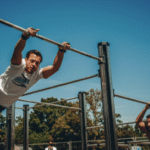How to Prepare for a Calisthenics Competition (A Houston Athlete’s Guide)
Preparing for a calisthenics competition, especially one held outdoors in a physically demanding city like Houston (often at locations like Memorial Park), requires a highly structured training plan that focuses on three key areas: Mastering Repetition Standards, Strategic Volume Peaking, and Environmental Acclimation.
Calisthenics competitions typically fall into two categories: Max Rep/Endurance (Pull-ups, Dips, Push-ups for volume or time) and Freestyle (static holds and dynamic movements). This guide focuses on preparation for Endurance/Max Rep events , which are most common for beginners.
- The Preparation Phase (8-12 Weeks Out)
The initial phase is dedicated to building a massive strength base and cleaning up fundamental form.
- Master Repetition Standards (NO REPS)
In competition, form is king . A “No Rep” can cost you the competition.
Identify Standards: Competition rules are strict. For example:
Pull-Ups: Must start from a dead hang (full elbow and shoulder lockout) and finish with the chin clearly above the bar (no kipping, swinging, or knee-bending allowed).
Dips: Must start at a full lockout and descend until the elbow angle is 90 degrees or less (shoulder must drop below the elbow).
Push-Ups: Must maintain a straight body line and typically involve the chest touching a specific object (like a shoe or box) for depth.
Action: Film yourself performing the exercises and self-critique against these standards. Every rep in training must be a perfect rep to build the correct muscle memory.
- Implement Endurance Training
Volume Over Intensity: Your weekly routine must shift to higher volume, often structured as a circuit or AMRAP (As Many Rounds As Possible) . Train the competition movements (Pull-up, Dip, Push-up) at least 3 times per week .
Timed Circuits (Density Training): Practice completing a high volume of reps in a short time frame (e.g., 50 pull-ups, 100 dips, and 150 push-ups). Reducing rest time forces your body to adapt to fatigue, which mimics the stress of competition.
- Mobility and Injury Prevention
Joint Conditioning: High volume can lead to elbow and wrist tendonitis. Spend 10 minutes before every session on wrist conditioning, elbow circles, and rotator cuff mobility drills to “bulletproof” the joints.
Targeted Recovery: Use foam rolling and static stretching (especially the lats and triceps) to maintain range of motion and prevent acute injury.
- The Peaking Phase (2 Weeks Out)
This is the transition from building volume to maximizing strength and recovery.
- Simulation and Testing
Competition Simulation: Exactly two weeks before the event, perform a full simulation of the competition routine (or max set) at the time of the event. Time yourself and have a partner judge your form stringently.
Weighted Calisthenics: If the competition includes a Weighted Category (Streetlifting), Week 2 should focus on heavy, low-rep sets (1RM or 3RM) for the pull-up and dip to peak CNS strength.
- Environmental Acclimation (The Houston Factor)
Pre-Heat Acclimation: If the event is outdoors in a Houston park during the summer (May–September), begin training a short, high-intensity circuit during the hottest part of the day (midday) 3–4 weeks out. This should be short (15-20 minutes) and done with aggressive hydration to help your body adapt to the heat index. This is vital for competition day performance.
Liquid Chalk: Ensure you have high-quality liquid chalk, as Houston’s humidity can make the competition bars dangerously slippery.
- The Deload and Execution Week (Final 7 Days)
This phase is about CNS rest and ensuring you enter the competition completely fresh.
Deload: Reduce all training volume by 70% (e.g., only 3 sets of 5 reps of each movement, far from failure). Do not lift maximal weights. The muscles must be rested, not fatigued.
Final Rest: Take the last 48 hours completely off from all physical activity. Focus on nutrition and hydration.
Competition Day Strategy:
Hydration/Electrolytes: Aggressively replenish electrolytes.
Warm-Up: Perform a long, dynamic warm-up that focuses on wrist and shoulder mobility. Do only 1–2 light sets of the competition movement to “feel” the bar, stopping far short of fatigue.
Execution: During the max rep attempt, maintain consistent tempo and focus on perfect form . Judges will stop counting if your form breaks (NO REP).
The key to success in a calisthenics competition is disciplined preparation and technical precision.

How to Prepare for a Calisthenics Competition (A Houston Athlete’s Guide)
Route
Calisthenics Gym Houston Functional Bodyweight Training
Secondary phone: (346) 483-3195
Email: info@calisthenicsclubhouston.com
URL: https://calisthenicsclubhouston.com/
Monday 6:00 AM - 7:00 PM Tuesday 6:00 AM - 7:00 PM Wednesday 6:00 AM - 7:00 PM Thursday 6:00 AM - 7:00 PM Friday 12:00 PM - 6:30 PM Saturday 9:45 AM - 12:00 PM Sunday 3:00 PM - 5:00 PM





